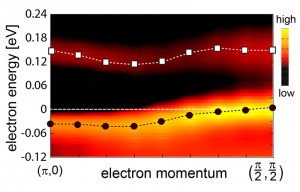Novel electronic structure on the way to high-temperature superconductivity Theory and experiment discover unprecedented structure

While the mechanism of high-temperature superconductivity in cuprates is still an open question, it is inferred that observed anomalies in a metallic state on the verge of superconductivity hold a key to the emergence of the superconductivity. Experimental study on the electronic structure of this anomalous metallic state has, however, been limited to the negative-energy region where electronic states are occupied. Because of the lack of experimental information on the positive-energy side, where electronic states are empty, most of studies so far have naively assumed an electronic structure with an energetically symmetric d-wave gap, which is equivalent to that of the superconducting state.
In their combined theoretical and experimental study on this positive-energy side, Assistant Professor Shiro Sakai, Associate Professor Yukitoshi Motome, and Professor Masatoshi Imada in the Department of Applied Physics have discovered that the gap structure in the anomalous metallic state is distinct from that of superconducting state, contrary to the common belief.
The researchers combined a massive supercomputer simulation of the electronic structure of a theoretical model of cuprate with an experiment (done by the group of Professor Alain Sacuto in University Paris 7), which illuminates the cuprate and measures the energy and intensity of light emitted from electrons. The analysis revealed a gap structure, where the electrons cannot exist, in a region on the positive-energy side.
The result suggests that the electronic structure of the anomalous metallic state, from which high-temperature superconductivity emerges, is essentially different from the one supposed in most previous studies, and therefore the present study is expected to be a game changer in the field.
Paper
S.Sakai, S.Blanc, M.Civelli, Y.Gallais, M. Cazayous, M.-A. M´easson, Wen, J. Xu, G. D. Gu, G. Sangiovanni, Y. Motome, K. Held, A. Sacuto, A. Georges, and M. Imada,
“Raman-scattering measurements and theory of the energy-momentum spectrum for underdoped bBi2Sr2CaCuO8+δ superconductors: Evidence of an s-wave structure of the pseudogap”,
Physical Review Letters 111, 107001 (2013), doi: 10.1103/PhysRevLett.111.107001.
Article link
Links
Graduate School of Engineering
Department of Applied Physics, Graduate School of Engineering
Imada Group, Department of Applied Physics, Graduate School of Engineering
Arita Laboratory, Department of Applied Physics, Graduate School of Engineering








